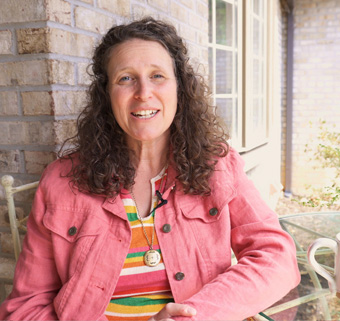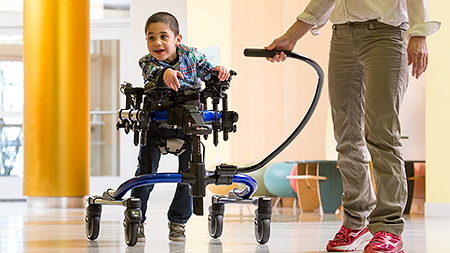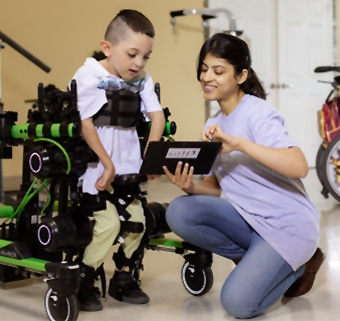Treadmill Base: A Solution for Gait Practice
| June 2018Body-weight-supported treadmill training (BWSTT) is widely recognized as a promising intervention to improve ambulation for individuals with neuromotor disability, with diagnoses including cerebral palsy¹, spinal cord injury² and stroke³.
With the external support of a device, we provide the postural control that clients lack so they are able to concentrate their physical energies on reciprocal step-taking. This external support may not only provide balance support but may also decrease the load on the limbs by providing weight bearing assist, thereby reducing energy expenditure and fatigue and enabling increased step-taking practice ⁴. Additionally, body weight support provides a safe support system, decreasing risk of fall and injury, and reducing the strain on the therapist who can focus on the person’s gait rather than on providing physical support. For children with cerebral palsy, BWSTT can be particularly effective for those classified as Level IV and Level V on the Gross Motor Function Classification System (GMFCS)⁵.
One research study documented the effects of exercise training using BWSTT with an 18-year-old non-ambulatory young man with cerebral palsy who was not receiving physical therapy. BWSTT provided him with a safe and feasible option to be physically active on a regular basis. Data showed that both his exercise time and speed increased with practice, and that his physiological cost index decreased. Even self-care and mobility showed improvements.⁶
In another study, a non-ambulatory 9-year-old child with spastic tetraplegic cerebral palsy gained the ability to take up to 60 steps on the treadmill while supported in that position. Additionally, after four months of BWSTT, he could walk short distances with minimal assistance over ground, using a rolling walker.⁷
The Rifton Pacer with dynamic upper frame used in combination with the treadmill base offers the additional benefit of motion in the vertical and horizontal planes. In normal gait, the center of gravity moves side-to-side and up and down as an individual transfers weight between the lower extremities to the stance limb, and to enable clearance of the swing limb. By providing for this motion in the support device this may further reduce the physical effort required to actively shift the center of gravity and achieve steps. Observing a student walking in the Pacer with the dynamic upper frame and multi-position saddle, one therapist commented, “The dynamic body weight seat allowed enough natural gait and rhythmic motion that significant changes in walking patterns were noticed immediately.”
In 2010, the Academy of Pediatric Physical Therapists put together a guideline for BWSTT.⁸ They recommend using the least amount of body weight support required to maintain postural alignment, and the least amount of manual assistance required for stepping. Their recommendations regarding frequency, session length, speed of treadmill, and episodes of treatment, based on the research available at that time, are shown in Table 1. More recent robotics research also suggests the value of adding resistance (counter-forces) to enhance muscle activation.⁹ ¹⁰
Table 1 APTA Guideline for Use of Body-Weight-Supported Treadmill Training
| Frequency | 2-5 days per week |
| Session length | 5-30 minutes per session (does not include set up or getting on/off equipment) |
| Treadmill speed | .05 mph-3mph |
| Episode of treatment | 2-16 weeks |
Those of us who are involved in gait practice in the therapy community acknowledge the value of gait training over a treadmill for health benefits and for potentially accelerating motor skill attainment in children with cerebral palsy and general developmental delay ¹¹, and perhaps more so when this is complemented with home-based BWSTT opportunity.¹² Research suggests that BWSTT decreases the overall metabolic cost of walking ¹³. However we must also recognize the role of overground gait practice. A study with healthy adults demonstrates that normal ground reaction forces (GRF) are not present during treadmill walking ¹⁴.
Research confirms that the body weight support and the moving treadmill surface influences muscle activation and timing and the overall gait pattern, such that over ground walking practice may offer a better carryover to functional gait with longer and faster strides. ¹⁵ ¹⁶ ¹⁷ A comparison between treadmill and overground training is offered in Table 2.
As one reviewer states, “Continued emphasis on progressive reduction of body weight support along with adding concurrent overground walking practice to a treadmill training protocol may increase the intensity of training and assist with carryover of improvements to overground walking.” ¹⁸
One distinct advantage of the Rifton Pacer upper frame used in combination with the treadmill base is that it can also be used over ground in the same treatment session, provided there is sufficient space in the exercise room.
Table 2 Comparison between PBWTT and OG
| Body Weight Support Treadmill Training (BWSTT) | Over Ground (OG) |
| Stride length and speed is impacted by the treadmill belt | Stride length and speed can be varied throughout the gait practice session by therapist and patient control of OG device |
| Gait cycle and muscle activation is stimulated and affected by movement of the treadmill belt | Gait cycle and muscle activation involves ground reaction forces and weight shifting of limbs resulting in proprioception and sensory input through feet that correlates with normal, functional walking |
| Direction of movement and gait cycle is repetitive and consistent | The option of directionality and motor planning by gait training through different routes in the environment promotes movement variability |
| Indoor gait practice opportunity in same location | Environmental challenges can be varied; gait practice can occur outdoors on level surfaces, providing a stimulating and enriched environment |
| Environment is static or unchanging; patient’s visual field remains the same | Patient navigates through the environment; patient’s visual field correlates with normal, functional walking |
References
1. Zwicker JG, Mayson TA. (2010) Effectiveness of treadmill training in children with motor impairments. Pediatr Phys Ther. 22(4):361–377. Free Full Text https://journals.lww.com/pedpt/fulltext/2010/22040/Effectiveness_of_Treadmill_Training_in_Children.6.aspx
2. Leech KA, Kinnaird CR, Holleran CL, Kahn J, Hornby TG. (2016) Effects of Locomotor Exercise Intensity on Gait Performance in Individuals With Incomplete Spinal Cord Injury. Phys Ther. 96(12):1919–1929. Free Full Text https://www.ncbi.nlm.nih.gov/pmc/articles/PMC5131185/
3. Hesse S (2008) Treadmill training with partial body weight support after stroke: a review.
NeuroRehabilitation. 23(1)55-65. Free Full Text https://content.iospress.com/download/neurorehabilitation/nre00394?id=neurorehabilitation%2Fnre00394
4. McNevin N, Craci L, Schafer J. Gait in adolescent cerebral palsy: the effect of partial unweighting. (2000) Arch Phys Med Rehabil. 81(4):525-28. Abstract https://www.sciencedirect.com/science/article/pii/S0003999300547571
5. Ronan S, Bingham E, Mushkat S, Sedman E. (2015) Recommended treadmill training parameters for persons with cerebral palsy based on the GMFCS levels: a systematic review. Dev Med Child Neurol. 57(S5):67. Free Full Text https://onlinelibrary.wiley.com/doi/full/10.1111/dmcn.109_12887
6. DiBiasio P, Lewis C. (2012) Exercise training utilizing body weight-supported treadmill walking with a young adult with cerebral palsy who was non-ambulatory. Physiother Theory Pract. 28(8):641-52. Abstract https://www.ncbi.nlm.nih.gov/pubmed/22432864
7. Day JA, Fox EJ, Lowe J, Swales HB, Behrman AL. (2004): Locomotor training with partial body weight support on a treadmill in a nonambulatory child with spastic tetraplegic cerebral palsy: a case report. Pediatr. Phys. Ther. 16:106-113. Free Full Text https://journals.lww.com/pedpt/Fulltext/2004/01620/Locomotor_Training_with_Partial_Body_Weight.5.aspx
8. APTA, Academy of Pediatric Physical Therapists. (2010) Body-Weight-Supported Treadmill Training: Using Evidence to Guide Physical Therapy Intervention. Accessed May 2018. https://pediatricapta.org/includes/fact-sheets/pdfs/Body-Weight-Supported-Treadmill.pdf
9. Wu M, Kim J, Gaebler-Spira D, Schmit B, Arora P. (2017) Robotic resistance treadmill training improves locomotor function in children with cerebral palsy: a randomized controlled pilot study. Arch Phys Med Rehabil. 98(11) :2126-33. Abstract: https://www.archives-pmr.org/article/S0003-9993(17)30367-2/pdf
10. Kang J, Martelli D, Vashista V, Martinez-Hernandez I, Kim H et al. (2017) Robot-driven downward pelvic pull to improve crouch gait in children with cerebral palsy. Sci Robot. 2(8) eaan2634. Abstract http://robotics.sciencemag.org/content/2/8/eaan2634
11. Valentín-Gudiol M, Mattern-Baxter K, Girabent-Farrés M, Bagur-Calafat C, Hadders-Algra M, Angulo-Barroso RM. (2017) Treadmill interventions in children under six years of age at risk of neuromotor delay. Cochrane Database Syst Rev. Jul 29;7:CD009242. Abstract https://www.ncbi.nlm.nih.gov/pubmed/28755534
12. Visser A, Westman M, Otieno S, Kenyon L. (2017) A home-based body weight-supported treadmill program for children with cerebral palsy: a pilot study. Pediatr Phys Ther. 29(3):223-29 Free Full Text https://journals.lww.com/pedpt/Abstract/2017/07000/A_Home_Based_Body_Weight_Supported_Treadmill.10.aspx
13. Colby SM, Kirkendall DT, & Bruzga RF. (1999) Electromyographic analysis and energy expenditure of harness supported treadmill walking: implications for knee rehabilitation. Gait & Posture.10(3): 200-205. Abstract https://www.ncbi.nlm.nih.gov/pubmed/10567751
14. Barela AM, de Freitas PB, Celestino ML, et al. (2014) Ground reaction forces during level ground walking with body weight unloading. Brazilian Journal of Physical Therapy.18(8): 572-579. Free Full Text https://www.ncbi.nlm.nih.gov/pmc/articles/PMC4311602/
15. Sandler EB, Roach KE, Field-Fote EC (2017) Dose-Response Outcomes Associated with Different Forms of Locomotor Training in Persons with Chronic Motor-Incomplete Spinal Cord Injury. J Neurotrauma. 34(10):1903-1908. Free Full Text https://www.ncbi.nlm.nih.gov/pmc/articles/PMC5444430/
16. Matsuno V, Camargo M, Palma G, Alveno D, Barela M. (2010) Analysis of partial body weight support during treadmill and overground walking of children with cerebral palsy. Rev Bras Fisioter. 14(5):404-10. Free Full Text http://www.scielo.br/scielo.php?script=sci_arttext&pid=S1413-35552010000500009&lng=en&nrm=iso&tlng=en
17. Celestino M, Gama G, Longuinho G, Fugita M, Barela A. (2014) Influence of body weight unloading and support surface during walking of children with cerebral palsy. Fisioter Mov. 27(4):591-9. Free Full Text: http://www.scielo.br/scielo.php?script=sci_arttext&pid=S0103-51502014000400591
18. Willoughby K, Dodd K, Shields N, Foley S. (2010) Efficacy of partial body weight-supported treadmill training compared with overground walking practice for children with cerebral palsy; a randomized controlled trial. Arch Phys Med Rehabil. 91:333-9. Free Full Text https://www.archives-pmr.org/article/S0003-9993(09)00932-0/fulltext




